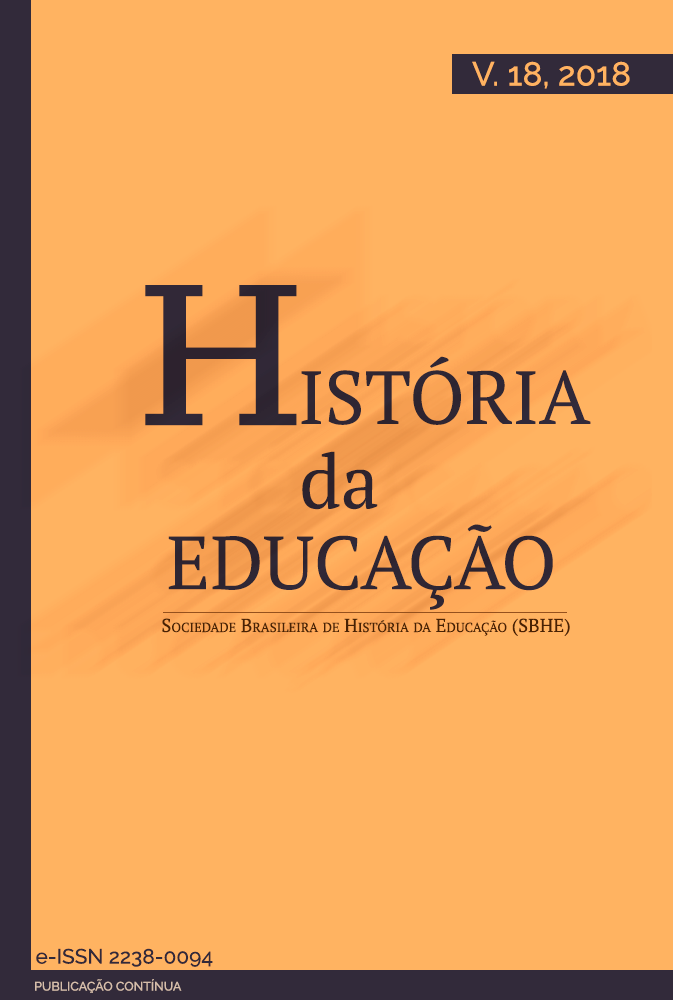Comenius and the instructive power of angels
Abstract
Juan Amos Comenius, a Moravian educator of the XVII century, produced several texts about education, philosophy, theology, science, among others. Following the tradition of hermetic, cabalistic and Rosicrucian studies, Comenius considered that the angels are not only guardians, but also teachers, who, in some cases, teach people directly. Starting with the questions raised by the texts of Frances Yates and Maria Lucia Spedo Hilsdorf about this specific angelic trait, we analyze the way that the angels are quoted in six different Comeniu’s books, namely, O labirinto do mundo e o paraíso do coração, Didática magna, Orbis sensualium pictus, A escola da infância, Pampaedia and O único necessário. We conclude that, for Comenius, the angels are an object of knowledge, beings who are present and teach through inspirations and dreams, but in extraordinary situations (and necessary) as the ones they lived, they could do their instructive action in a more incisive and present way. We also point to the inseparability (and continuity) between the questions of the divine and mundane realm in the Comenius’view of knowledge and education.Downloads
References
Aguiar, T. B. (2015). ‘Minor’ educator before Comenius: Petr Chelčícký’s pacifism. Acta Scientiarum.Education. 37(1), 35-46.
Bíblia de Jerusalém (2010). São Paulo: Paulus.
Bollis, R. A. R. (2015). Comenius: um educador em três tempos (Dissertação de Mestrado). Universidade Metodista de Piracicaba, Piracicaba.
Comenius, J. A. (2016). Didática magna. São Paulo: Editora WMF Martins Fontes.
Comenius, J. A. (2010) O Labirinto do Mundo e o Paraíso do Coração. São Paulo: Editora Comenius.
Comenius, J. A. (2011). A escola da infância. São Paulo: Editora Unesp.
Comenius, J. A. (2014). Pampaedia (Educação Universal). São Paulo: Editora Comenius.
Comenius, J. A. (2015). O único necessário. Jarinu: Pentagrama Publicações.
Comenius. J. A. (1896). The Great Didactic of John Amos Comenius. Londres: Adam and Charles Black.
Dee, J. (2011). Dr John Dee’s Spiritual Diary (1583-1608). Singapore: Golden Hoard.
Gomes, J. F. (1996). Introdução. In J. A. Coménio, Didáctica magna. Lisboa: Fundação Calouste Gulbenkian.
Gomes, J. F. (1971). A “Pampaedia” de Coménio. In J. A. Coménio, Pampaedia (educação universal). Coimbra: Faculdade de Letras da Universidade de Coimbra.
Hilsdorf, M. L. S. (2006). O aparecimento da escola moderna. Belo Horizonte: Autêntica.
Komenský, J. A. (2012). Orbis sensualium pictus. Brno: Machart.
Kulesza, W. A. (1992). Comenius: a persistência da utopia em educação. Campinas: Editora da Unicamp.
Pospíšil, J. (2009). Didatics as the way out of the labyrinth In Chocholová, S., Pánková, M. & Steiner, M. (Eds.) Jan Amos Komenský: odkaz kultuře vzdělávání. Praga: Academia.
Seville, I. (2006). The etymologies. New York: Cambridge University Press.
Yates, F. A. (1964). Giordano Bruno e a tradição hermética. São Paulo: Editora Cultrix.
Yates, F. A. (1972). O Iluminismo Rosa-cruz. São Paulo: Editora Pensamento.
Voldan, H. (2009). From the labyrinth to the one/ex labirinth ad unum. In Chocholová, S., Pánková, M. & Steiner, M. (Eds.) Jan Amos Komenský: odkaz kultuře vzdělávání. Praga: Academia.
Copyright (c) 2018 Thiago Borges de Aguiar, Thiago Elias Vieira Pereira

This work is licensed under a Creative Commons Attribution 4.0 International License.
Os direitos autorais pertencem exclusivamente aos autores. Os direitos de licenciamento utilizados pelo periódico consistem na licença Creative Commons Attribution 4.0 (CC BY 4.0): são permitidos o acompartilhamento (cópia e distribuição do material em qualqer meio ou formato) e adaptação (remix, transformação e criação de material a partir do conteúdo assim licenciado) para quaisquer fins, inclusive comerciais.
Recomenda-se a leitura desse link para maiores informações sobre o tema: fornecimento de créditos e referências de forma correta, entre outros detalhes cruciais para uso adequado do material licenciado.













